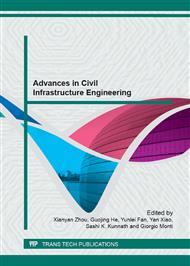p.911
p.917
p.925
p.930
p.935
p.939
p.943
p.947
p.952
Experimental Study of the Impact of Soil Particles Loss on Soil Settlement in Vacuum Dewatering
Abstract:
Vacuum method, combined with well dewatering method, has been proved to be an effective way to solve perched water, weak aquifers water and interface residual water problems in underground construction. However, there were not enough researches on soil settlement in vacuum dewatering from soil particle loss perspective which is one of the most critical factors in vacuum dewatering. In order to research the effect of vacuum on soil settlement, two experiments were conducted. The first experiment was designed to simulate well dewatering method without vacuum. As a contrast, the other one was conducted under vacuum pressure. Then the particle size distribution curves of the soil which were obtained from the water respectively drained from the two experiments were analyzed. At the same time, the settlements of soil column were compared. The experiment result shows that the vacuum dewatering method discharges more small particles than well dewatering method, which contributes to the settlement of the soil.
Info:
Periodical:
Pages:
935-938
Citation:
Online since:
January 2013
Authors:
Keywords:
Price:
Сopyright:
© 2013 Trans Tech Publications Ltd. All Rights Reserved
Share:
Citation:


